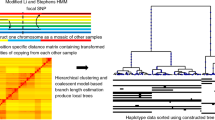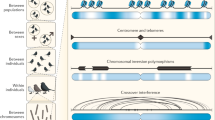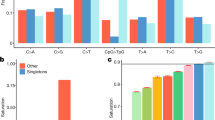Abstract
Variation in the human genome sequence is key to understanding susceptibility to disease in modern populations and the history of ancestral populations. Unlocking this information requires knowledge of the patterns and underlying causes of human sequence diversity. By applying a new population-genetic framework to two genome-wide polymorphism surveys, we find that the human genome contains sizeable regions (stretching over tens of thousands of base pairs) that have intrinsically high and low rates of sequence variation. We show that the primary determinant of these patterns is shared genealogical history. Only a fraction of the variation (at most 25%) is due to the local mutation rate. By measuring the average distance over which genealogical histories are typically preserved, these data provide the first genome-wide estimate of the average extent of correlation among variants (linkage disequilibrium). The results are best explained by extreme variability in the recombination rate at a fine scale, and provide the first empirical evidence that such recombination 'hot spots' are a general feature of the human genome and have a principal role in shaping genetic variation in the human population.
This is a preview of subscription content, access via your institution
Access options
Subscribe to this journal
Receive 12 print issues and online access
$209.00 per year
only $17.42 per issue
Buy this article
- Purchase on Springer Link
- Instant access to full article PDF
Prices may be subject to local taxes which are calculated during checkout






Similar content being viewed by others
Accession codes
Accessions
GenBank/EMBL/DDBJ
References
Sachidanandam, R. et al. A map of human genome sequence variation containing 1.42 million single nucleotide polymorphisms. Nature 409, 928–933 (2001).
Li, W.H. & Sadler, L.A. Low nucleotide diversity in man. Genetics 129, 513–523 (1991).
Altshuler, D. et al. An SNP map of the human genome generated by reduced representation shotgun sequencing. Nature 407, 513–516 (2000).
Mullikin, J.C. et al. An SNP map of human chromosome 22. Nature 407, 516–520 (2000).
Lander, E.S. et al. Initial sequencing and analysis of the human genome. Nature 409, 860–921 (2001).
Cargill, M. et al. Characterization of single-nucleotide polymorphisms in coding regions of human genes. Nature Genet. 22, 231–238 (1999).
Cambien, F. et al. Sequence diversity in 36 candidate genes for cardiovascular disorders. Am. J. Hum. Genet. 65, 183–191 (1999).
Halushka, M.K. et al. Patterns of single-nucleotide polymorphisms in candidate genes for blood-pressure homeostasis. Nature Genet. 22, 239–247 (1999).
Wang, D.G. et al. Large-scale identification, mapping, and genotyping of single- nucleotide polymorphisms in the human genome. Science 280, 1077–1082 (1998).
Venter, J.C. et al. The sequence of the human genome. Science 291, 1304–1351 (2001).
Li, W.-H. Molecular Evolution (Sinauer Associates, Sunderland, Massachusetts, 1997).
Griffiths, R.C. in Selected Proceedings of the Sheffield Symposium on Applied Probability, IMS Lecture Notes Vol. 18 (eds I.V. Basawa & R.L. Taylor) 100–117 (Institute of Mathematical Statistics, 1991).
Griffiths, R.C. Neutral two-locus multiple allele models with recombination. Theor. Popul. Biol. 19, 169–186 (1981).
Kaplan, N. & Hudson, R.R. The use of sample genealogies for studying a selectively neutral m-loci model with recombination. Theor. Popul. Biol. 28, 382–396 (1985).
Hudson, R.R. Properties of a neutral allele model with intragenic recombination. Theor. Popul. Biol. 23, 183–201 (1983).
Hudson, R.R. in Oxford Surveys in Evolutionary Biology (eds Futuyma, D.J. & Antonovics, J.) 1–44 (Oxford Univ. Press, Oxford, 1990).
Sved, J.A. Linkage disequilibrium and homozygosity of chromosome segments in finite populations. Theor. Popul. Biol. 2, 125–141 (1971).
Yu, A. et al. Comparison of human genetic and sequence-based physical maps. Nature 409, 951–953 (2001).
Hudson, R.R. Testing the constant-rate neutral allele model with protein sequence data. Evolution 37, 203–217 (1983).
Takahata, N. & Satta, Y. Evolution of the primate lineage leading to modern humans: phylogenetic and demographic inferences from DNA sequences. Proc. Natl Acad. Sci. USA 94, 4811–4815 (1997).
Kimura, M. The Neutral Theory of Molecular Evolution (Cambridge Univ. Press, Cambridge, 1983).
Lander, E.S. & Schork, N.J. Genetic dissection of complex traits. Science 265, 2037–2048 (1994).
Kruglyak, L. Prospects for whole-genome linkage disequilibrium mapping of common disease genes. Nature Genet. 22, 139–144 (1999).
Risch, N.J. Searching for genetic determinants in the new millennium. Nature 405, 847–856 (2000).
Devlin, B. & Risch, N. A comparison of linkage disequilibrium measures for fine-scale mapping. Genomics 29, 311–322 (1995).
Strobeck, C. & Morgan, K. The effect of intragenic recombination on the number of alleles in a finite population. Genetics 88, 829–844 (1978).
Ohta, T. & Kimura, M. Linkage disequilibrium between two segregating nucleotide sites under the steady flux of mutations in a finite populations. Genetics 68, 571–580 (1971).
Reich, D.E. et al. Linkage disequilibrium in the human genome. Nature 411, 199–204 (2001).
Abecasis, G.R. et al. Extent and distribution of linkage disequilibrium in three genomic regions. Am. J. Hum. Genet. 68, 191–197 (2001).
Dunning, A.M. et al. The extent of linkage disequilibrium in four populations with distinct demographic histories. Am. J. Hum. Genet. 67, 1544–1554 (2000).
Taillon-Miller, P. et al. Juxtaposed regions of extensive and minimal linkage disequilibrium in human Xq25 and Xq28. Nature Genet. 25, 324–328 (2000).
Gabriel, S.B. et al. The structure of haplotype blocks in the human genome. Science 297, 2225–2229 (2002); published online 23 May 2002 (10.1126/science.1069424).
Przeworski, M., Hudson, R.R. & Di Rienzo, A. Adjusting the focus on human variation. Trends. Genet. 16, 296–302 (2000).
Reich, D.E. & Goldstein, D.B. Genetic evidence for a Paleolithic human population expansion in Africa. Proc. Natl Acad. Sci. USA 95, 8119–8123 (1998).
Kimmel, M. et al. Signatures of population expansion in microsatellite repeat data. Genetics 148, 1921–1930 (1998).
Tishkoff, S.A. et al. Global patterns of linkage disequilibrium at the CD4 locus and modern human origins. Science 271, 1380–1387 (1996).
Wakeley, J. Nonequilibrium migration in human history. Genetics 153, 1863–1871 (1999).
Chakravarti, A. et al. Nonuniform recombination within the human β-globin gene cluster. Am. J. Hum. Genet. 36, 1239–1258 (1984).
Daly, M.J., Rioux, J.D., Schaffner, S.F., Hudson, T.J. & Lander, E.S. High-resolution haplotype structure in the human genome. Nature Genet. 29, 229–232 (2001).
Jeffreys, A.J., Ritchie, A. & Neumann, R. High resolution analysis of haplotype diversity and meiotic crossover in the human TAP2 recombination hotspot. Hum. Mol. Genet. 9, 725–733 (2000).
Jeffreys, A.J., Kauppi, L. & Neumann, R. Intensely punctate meiotic recombination in the class II region of the major histocompatibility complex. Nature Genet. 29, 217–222 (2001).
Cavalli-Sforza, L.L., Menozzi, P. & Piazza, A. The History and Geography of Human Genes (Princeton Univ. Press, Princeton, New Jersey, 1994).
Kong, A. A high resolution recombination map of the human genome. Nature Genet. 31, 241–247 (2002); advance online publication, 10 June 2002 (doi:10.1038/ng917).
Lui, B.H. in Statistical Genomics: Linkage, Mapping, and QTL Analysis (CRC Press, Boca Raton, Florida, 1998).
Broman, K.W., Murray, J.C., Sheffield, V.C., White, R.L. & Weber, J.L. Comprehensive human genetic maps: individual and sex-specific variation in recombination. Am. J. Hum. Genet. 63, 861–869 (1998).
Nachman, M.W. & Crowell, S.L. Estimate of the mutation rate per nucleotide in humans. Genetics 156, 297–304 (2000).
Acknowledgements
We thank T. Lavery, A. Rachupka and J. Platko for assistance with great ape sequencing; B. Gilman for computer support; D. Cutler, P. Donnelly, J. Hirschhorn, L. Kruglyak, S. Myers, J. Pritchard and J. Wakeley for discussions and advice; and the laboratory of E. Green and the Baylor Sequencing Center for depositing large-insert chimpanzee sequences into GenBank. D.E.R. was supported in part by a National Defense Science and Engineering fellowship. D.A. is a Charles E. Culpeper Scholar of the Rockefeller Brothers Fund and a Burroughs Wellcome Fund Clinical Scholar in Translational Research. This work was supported by grants from The SNP Consortium to E.S.L. and D.A., the Massachusetts General Hospital to D.A. and the National Institutes of Health to E.S.L..
Author information
Authors and Affiliations
Corresponding author
Ethics declarations
Competing interests
The authors declare no competing financial interests.
Supplementary information
Rights and permissions
About this article
Cite this article
Reich, D., Schaffner, S., Daly, M. et al. Human genome sequence variation and the influence of gene history, mutation and recombination. Nat Genet 32, 135–142 (2002). https://doi.org/10.1038/ng947
Received:
Accepted:
Published:
Issue Date:
DOI: https://doi.org/10.1038/ng947
This article is cited by
-
Evaluation of microhaplotypes in forensic kinship analysis from a Swedish population perspective
International Journal of Legal Medicine (2021)
-
A new strategy to confirm the identity of tumour tissues using single-nucleotide polymorphisms and next-generation sequencing
International Journal of Legal Medicine (2020)
-
Utility of ForenSeq™ DNA Signature Prep Kit in the research of pairwise 2nd-degree kinship identification
International Journal of Legal Medicine (2019)
-
The Arf6 activator Efa6/PSD3 confers regional specificity and modulates ethanol consumption in Drosophila and humans
Molecular Psychiatry (2018)
-
Parallel Analysis of 124 Universal SNPs for Human Identification by Targeted Semiconductor Sequencing
Scientific Reports (2015)



